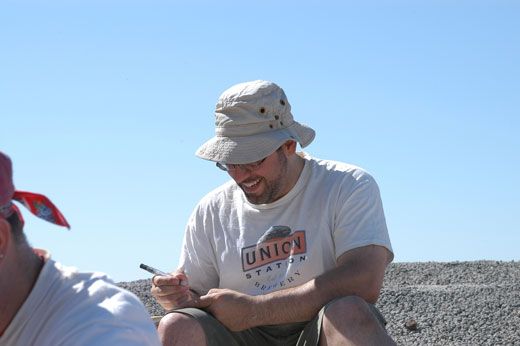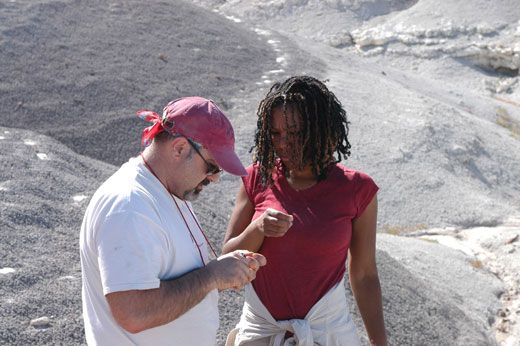Dinosaur Dispatch: Days 3 and 4
The paleontology team is finally in place. After setting up camp, the dig begins. Fossils are found and dinosaur tracks investigated
/https://tf-cmsv2-smithsonianmag-media.s3.amazonaws.com/filer/Dispatch2_4_Belamnite-631.jpg)
After three days on the road, we reach Wyoming. Along the way, our 1992 Suburban (retrofitted with iPod, laptop, and DVD player attachments) crossed the Mississippi and Wisconsin rivers at historic flood levels. Although it was obvious from our windows that water levels were high, we saw no sign of the devastation. However, we were forced to take a two and a half hour detour to drive ten miles north of Madison, Wisconsin.
Once we reach Wyoming, we meet up with Dr. Matthew Carrano, Jon Mitchell and Steve Jabo at the Greybull A&W drive-in.
Mitchell attends Appalachian State University as a geology major. He is part of the Smithsonian’s Research Training Program and is interning with Carrano this summer.
Jabo prepares vertebrate fossils at the Smithsonian. He excavates fossils, gets them back to the museum safely and exposes the specimens so that they can be studied..
Ruth Middleton, who was with Dr. Gina Wesley Hunt and me on our road trip, is a student at Montgomery College, studying early education. She hopes to use this experience to bring the excitement of science into the classroom and closer to the lives of her students.
With the crew now together, we head out from the A&W to our first camp near Shell, a small hamlet about 5 miles away. The land we camp on is owned by a very generous couple, the Manuels, whose family has lived in the Shell area since the early 1900s. Their family has assisted paleontologists working in the area for almost a century now and the Smithsonian paleontologists have personally known the family for more than a decade.
Inside the camp, we have a small RV, a gas grill, lawn chairs, a view of the Big Horn Mountains and an air-conditioned house with showers and real toilets less than two minutes away. It is almost too comfortable. Suffice it to say, we aren’t completely submerged in the camping experience quite yet.
On our first day in the field, we surface collect a type of deposit called a microsite at Ostrom’s Beach. In microsites, thousands of small fossils are concentrated in one place. The rock layer we look at is called the Cloverly Formation, from the Early Cretaceous about 120 million years ago. Although we don’t discover any new dinosaurs, we find several small crocodile and theropod teeth, as well as bits of bone fragments and some large pieces of turtle plastron, which is the flat underside of the shell. Just behind the microsite, in what’s known as “the bowl,” we find larger, but still fragmented fossils that don’t have very much scientific value because so little information can be derived from the fragments. Erosion can actually be a big help in this line of work. Matt still visits every year in case anything new and interesting is uncovered by nature. “John Ostrom was a famous paleontologist from Yale University, and he was the first to collect from this site back in the 1960s,” explains Matt. “His work here was very important, and so we decided to name the site after him.”
After leaving “the bowl” we take a look at a very large exposure of dinosaur tracks. The footprints are millions of years old and represent multiple dinosaurs walking along what was once a beach. The Sundance Formation, where this tracksite is located, was previously thought to be a much deeper ocean. However, these footprints disprove that idea and indicate the area was actually much shallower. “Ancient footprints bring alive the fact that the fossils we find were once living breathing animals, and approximately 160 million years ago, several dinosaurs walked along this beach. Were they looking for food, or walking to a watering hole? We may never know, but that event on that day in the Jurassic has been preserved for millions of years”, says Wesley-Hunt.
On our way back to camp, we stop at another part of the Sundance Formation and pick up a few belemnites. Belemnites are a very common marine invertebrate fossil in this locality. They are cephalopods (mollusks), very similar to the modern squid. The bullet-shaped shells we found are part of what originally gave the animal internal structure.
As we are get ready to turn in after our first day of work, Wesley-Hunt yells at us to get out of the RV and off the computer to come see the full moon rising over the red cliffs.

